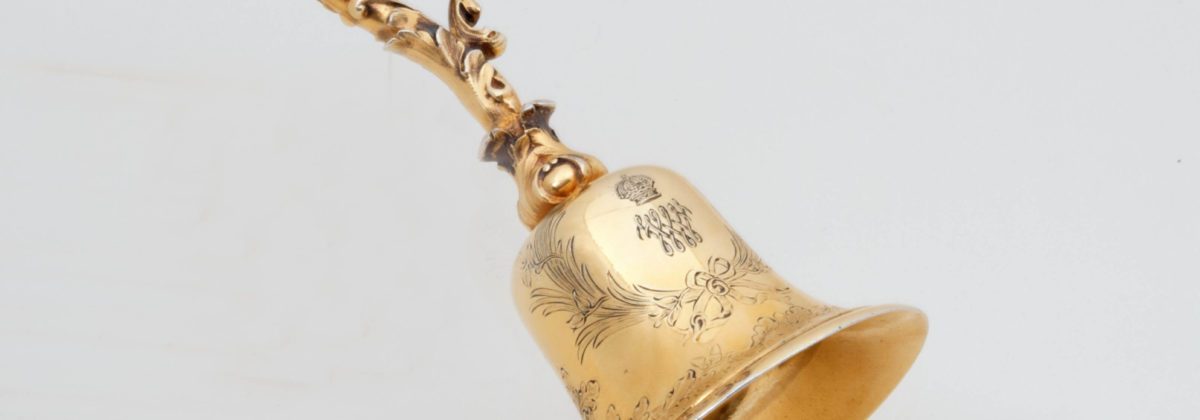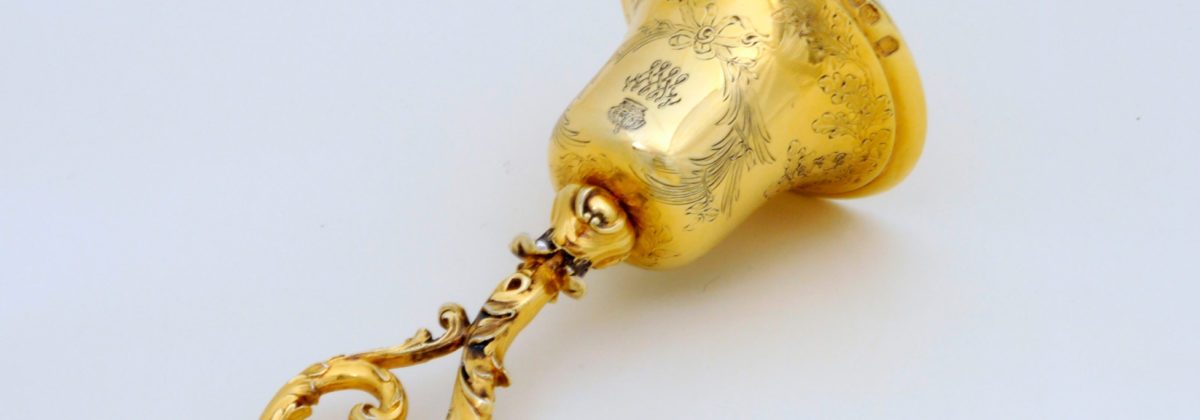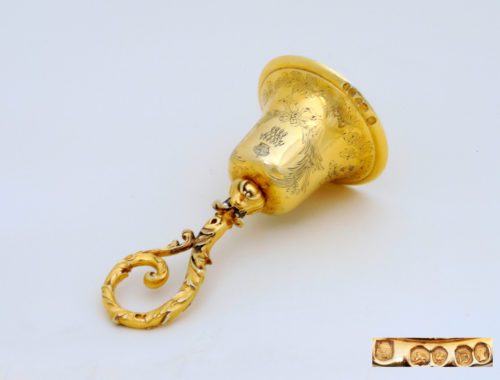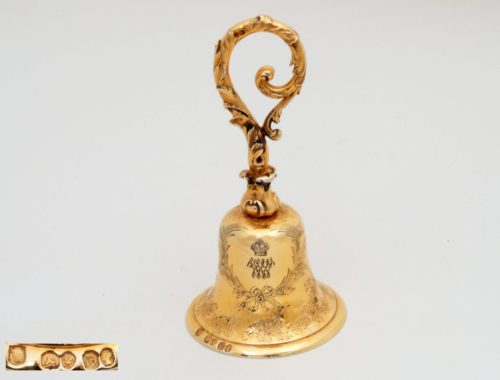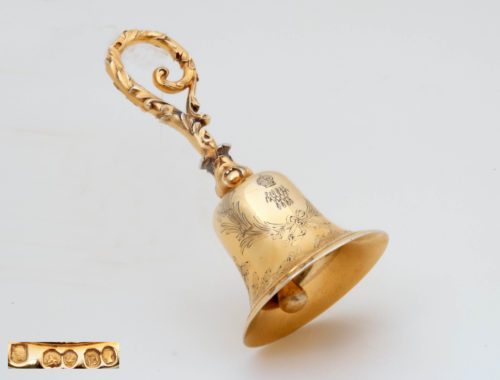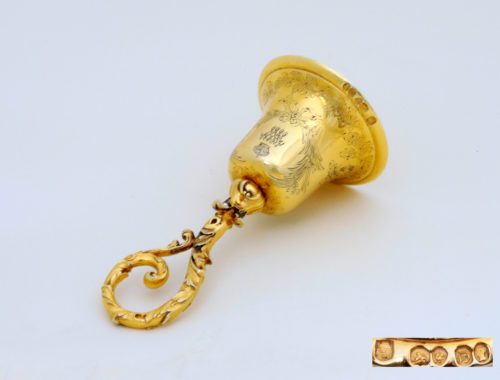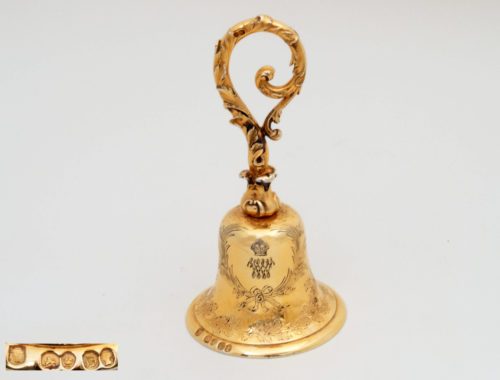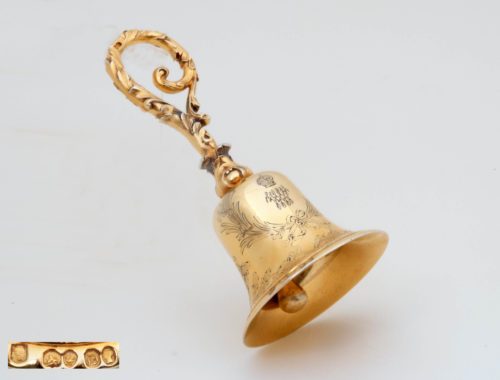Object Number: 1008
London 1839
Mortimer & Hunt
City’s hallmark: Lion’s head for London (Jackson 1921: 88)
Sterling silver mark: Lion passant gardant (Jackson 1921: 88)
Date letter for 1839
Duty mark: King’s head in an oval stamp. This mark was on all gold and silver objects assayed in England and Scotland from 01.12.1784 to 30.04.1890. The mark consists of the head of the reigning sovereign in profile, looking to the right of the observer (but the head of Queen Victoria looks to the left) (Jackson 1921: 72 & 88).
Maker’s mark: “IM/&/ISH” für John Mortimer und John Samuel Hunt (mark since1839) (Fallon, p. 165).
H.: 12,5 cm (4 7/8 in.); W.: 240 gr. (7oz. 14dwt.)
Detailed Information
Royal Silver-Gilt Table Bell for Frederick William, King of Prussia
This lovely and heavy silver-gilt table bell is finely adorned. The body is round, and the sound bow is spreading. The large, cast scroll handle is ornated with foliate. The body is chased with a bouquet of roses, thistles and shamrock, while in the middle, the cypher of Frederick William IV of Prussia with a crown is engraved above an oak band and within palm and laurel wreaths.
Provenance
The roses (Tudor rose), thistles (Scotland) and shamrock (Ireland) are the national symbols of England, Scotland and Ireland, while the oak, is a national symbol of Germany. These floral choices suggest that this bell supplied by Mortimer & Hunt, jewellers and goldsmiths to the royal family was a gift from a member of British royalty to Frederick William IV (1795-1861) whose cypher is engraved on it and who had become King of Prussia in 1840, at the death of his father.
Frederick William was senior royal sponsor (godparent) at the Christening of Queen Victoria’s son Albert Edward (Edward VII (1841-1910)) at St George’s Chapel, Windsor, in 1842.
King Frederick William IV (1795-1861)
The Prussian King Frederick William IV (1795-1861)is best known for the many buildings he had constructed in Berlin and Potsdam, as well as for the completion of the Cologne Cathedral.
He was interested in both architecture and landscape gardening and was a patron of several German artists, including the architect Karl Friedrich Schinkel and the composer Felix Mendelssohn. In 1823 he married Elisabeth Ludovika of Bavaria (1801-73), a Roman Catholic, converted to Lutheranismafter intensive negotiations. The couple had a harmonious marriage but remained childless.
Frederick William became King of Prussia on the death of his father in 1840.
Cultural History of the Bell
The bell has centuries of cultural history and is not a single creation of Christian, western culture. Bell is the name given to a sound instrument – usually a cup-shaped vessel which is hollow and inside is brought to ringing tones by a clapper which vibrates.
Originally the bell served to frighten and drive away demons and enemy powers. They were therefore included in the ritual and religious actions of many religions. Gradually bells got a musical quality, which secured a harmony in the church.
In the secular world bells were often used as signal instruments. Since the Middle Ages, bells have been known as a call to pay taxes; the beer bell as a signal to open taverns; the storm bell as an alarm in a storm or other dangerous situation.
Silver Table Bells
Small bells served, among others, the monarchs, the politicians in parliament and the judges in the courtroom. They gradually became a part of the tableware as table bells. As such they have spread especially since the Renaissance. In the beginning, table bells were used more in courtyards. The demand for silver table bells has increased since the seventeenth and especially the eighteenth century.
Maker
Mortimer & Hunt was a firm where Paul Storr worked. In 1807, he entered into a business agreement with the royal goldsmiths Rundell, Bridge & Rundell. Since 1822, he entered into partnership with John Mortimer, naming the firm Storr & Mortimer. Around 1826, Storr’s nephew by marriage, John Samuel Hunt, who already worked for Storr for many years, he joined the partnership. In 1838, when Storr retired, the firm was renamed to Mortimer & Hunt. The new partners were John Mortimer, John Samuel Hunt and John Hunt (son of the second). When John Mortimer retired in 1843, the other two partners entered into partnership with Robert Roskell and Charles Frederick Jamcock, chaning the firm’s name to Hunt & Roskell.
It seems that the Queen Victoria has given several orders for her gifts at Mortimer & Hunt around 1840 as a cutlery set and other silver objects in the V&A Museum testify.
Literature
Fallon, John P., Marks of London Goldsmiths and Silversmiths 1837-1914, London: Barrie & Jenkins, 1992.
Lange, Anselm, Europäische Tischglocken: klingende Kostbarkeiten vom Mittelalter bis zur Gegenwart. Mit Beiträgen aus der Kulturgeschichte der Glocke, Kornwestheim: Minner-Verlag, 1981.


